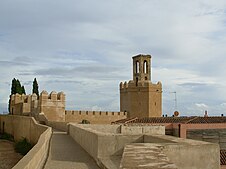Almohad art
The moral laxity and degradation of customs of the Almoravids gave rise to a new rigorist movement, the Almohads, al-muwahhidun "the unitaries". It was headed by Ibn Túmart who came from a tribal background in the High Atlas. His successor, Abd al-Mumin, named himself caliph, took Marrakech in 1147, and undertook the conquest of the rest of the empire, including Tunisia. Al-Andalus was definitively incorporated by his successor Abu Yaqub Yúsuf who chose, in 1172, Seville as the capital of the new empire.
Features
The return to the most extreme austerity became, even more rapidly than in the case of its predecessors, one of the most brilliant artistic moments, particularly in the field of architecture. Thus, Almohad art (1130-1269) will continue the Almoravid trail, consolidating and deepening its typologies and ornamental motifs. You are going to build with the same materials: brick, plaster, mortar and wood. And, it will maintain the pillar and the arches used in the previous period as support.
Religious architecture
Its mosques, except for the unfinished one in Rabat, will follow the model of the Tlemcen mosque, with naves perpendicular to the qibla wall. In them, a "T" through domes that are made of muqarnas in the Tinmal mosque and in the Kutubiyya of Marrakech. Likewise, the Kutubiyya, Hasan's and Seville's have minarets that are very similar to each other. They are characterized by their square plan and their elevation made up of two towers, one of which houses the other and between which runs a staircase or a ramp in the case of the Giralda in Seville. The inner tower is made up of superimposed vaulted rooms that will have a later impact on the Mudejar bell towers, especially in Aragon.
Palatine architecture
It develops the transept courtyards that had already made their appearance in Medina al-Zahra, although it is at this time that they take on great prominence. The best testimonies of it are found in the Alcázar of Seville where the patio of the Casa de Contratación and another, currently underground, known as the Jardín Crucero or the Baños de Doña María de Padilla have been preserved. These were possibly traced by master builders who built the transept patio of Castillejo de Monteagudo, ordered to be built by the Berber ruler of the independent kingdom of Murcia. This scheme will be taken up again in the Nasrid and Mudejar patios. The same repercussion will have another novelty that appears in the Patio del Yeso of the Seville Alcázar. It consists of placing a few small openings or windows covered with stucco lattice over the access opening to a room to allow lighting and ventilation.
Military architecture
It underwent a typological enrichment and a refinement of its defensive effectiveness of great importance, even for the Christian world. Complex doors appear in a bend so that the attackers, when advancing, leave one of their flanks exposed; polygonal towers to deviate the angle of fire; watchtowers separated from the walled enclosure but joined to it at the top by an upper arch and whose projection increases its defensive effectiveness compared to a normal tower; corach walls that run perpendicular to the walled enclosure in order to protect a water intake, a door and avoid complete encirclement; as well as barbicans or antemuros. Among the fortifications, the citadels of Cáceres, Badajoz, where the Espantaperros watchtower is located, and Seville stand out; The famous polygonal albarrana tower known as the Torre del Oro belongs to the latter. The Almohads were also among the first to use ribbed vaults to cover military rooms, since until then this type of covering had been used almost exclusively in buildings religious (such as the mosque in Córdoba and the Bab al-Mardum in Toledo). The best preserved in military architecture are in the castle of Villena, the Almohad wall of Palma del Río (Córdoba) and that of Biar.
Decorative arts
In the field decorative they applied a repertoire characterized by sobriety, order and rationalism. This resulted in the appearance of wide motifs that leave free spaces in which geometric intertwining, smooth plant forms and the most novel ornamental feature, the sebqa, triumph. This composition that decorates the Giralda, consists of a double rhomboid pattern on two planes made up of superimposed decorative arches starting from the keystone of the lower ones. Another architectural decoration that appears in this same minaret and in the Kutubiyya is ceramics, in which the tile technique is applied; that is to say, cut pieces that, combined with each other, make up a decorative motif.
On other occasions, these manifestations combine the ornamental and functional character. This is the case of the wood with which the pair and knuckle roofs with braces were made, the oldest example of which covers the axial nave of the Kutubiyya in Marrakech. These armors were called to acquire a major role in Mudejar art.
Artistic productions from this period are less well represented because of their confusion with those of other artistic periods. This is the case with fabrics that are difficult to distinguish from Mudejar. They accuse a practical absence of figurative motifs as well as an increase in geometric and epigraphic decoration based on the insistent repetition of Arabic words such as "blessing" and "happiness". In the metalwork, ewers representing animal figures decorated with chiseled plant incisions stand out, such as the Monzón de Campos lion, which until recently was considered a Caliphate piece.
Contenido relacionado
Anglo-Saxons
Colombia's shield
Steve Wozniak





